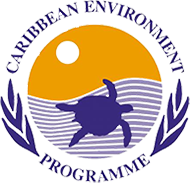Stony Coral Tissue Loss Disease (SCTLD) is a rapidly spreading disease affecting over 20 species of hard corals in the Caribbean. These are some of the slowest-growing and longest-lived reef-building corals. It was discovered first in the reefs of Florida in 2014 and has since then spread and been found in corals in parts of the Caribbean. It is suspected to be a bacterial pathogen spreading by contact or through waterways. SCTLD has high mortality rate and can cause death of a colony within weeks to months.
Given that there are two species of stony coral found in Annex II of the SPAW Protocol (Orbicella annularis and Orbicella faveolata) which fall in the category of Intermediately Susceptible Species, monitoring this disease is of great importance to the Secretariat of the Cartagena Convention.
Interestingly, Acropora cervicornis and Acropora palmata which are listed in Annex II are not affected and are categorized under Low Susceptible Species.
Consequences of SCTLD
The reefs of the Caribbean consist of over 60 species of corals and 1500 species of fish. They are important for local economy, creating income for tourism, fisheries, pharmaceutical industries, as well as protecting the coastline and vulnerable communities against impacts of climate change, erosion, flooding and hurricane and storm damage. Fishing and tourism are two very important sectors in the region. A study by The Nature Conservancy found that reef-associated tourism generates over $7.9 billion for Caribbean economies annually.
The impacts from SCTLD therefore puts the economy of the Caribbean at great risk.
Measures taken
This issue is addressed in the recent decisions of the 10th Meeting of the Contracting Parties (COP) of the SPAW Protocol and the 15th COP of the Cartagena Convention Secretariat, both held in Roátan, Honduras (June 2019). In August 2019 the Gulf and Caribbean Fisheries Institute (GCFI) held a peer-to-peer workshop for 34 participants including twenty-two marine natural resource managers from 17 countries / territories in the Wider Caribbean. The workshop provided capacity-building support to areas affected or susceptible to transmission of SCTLD and was also supported by the SPAW Protocol. >
Historical Timeline
Fall 2014: Isolated sites with significant coral disease were reported near Virginia Key (Miami-Dade County).
Fall 2015: Widespread disease was confirmed as far north as Pompano Beach down to Biscayne National Park.
Summer 2016: The disease continued to spread to Palm Beach County and to the Upper Florida Keys (Lower Matecumbe Key).
Spring 2017: Reports of widespread disease were confirmed as far north as St. Lucie Inlet in Martin County and to the southern boundary of the Upper Florida Keys.
Spring 2018: The disease expanded into the Lower Florida Keys and was in Jamaica.
Summer 2018: Signs of disease were reported in the Mexican Caribbean.
Fall 2018: Disease corals were discovered in St. Maarten.
Winter 2018-2019: The disease outbreak reached beyond Key West, and disease signs were reported in St. Thomas, USVI.
Spring 2019: Disease observed in the Dominican Republic and Turks and Caicos.
Summer 2019: Disease detected in Belize and St. Eustatius.
Winter 2019-2020: Disease reported in St. John, USVI, Culebra, Puerto Rico, and Grand Bahama Island, Bahamas (NOAA).






